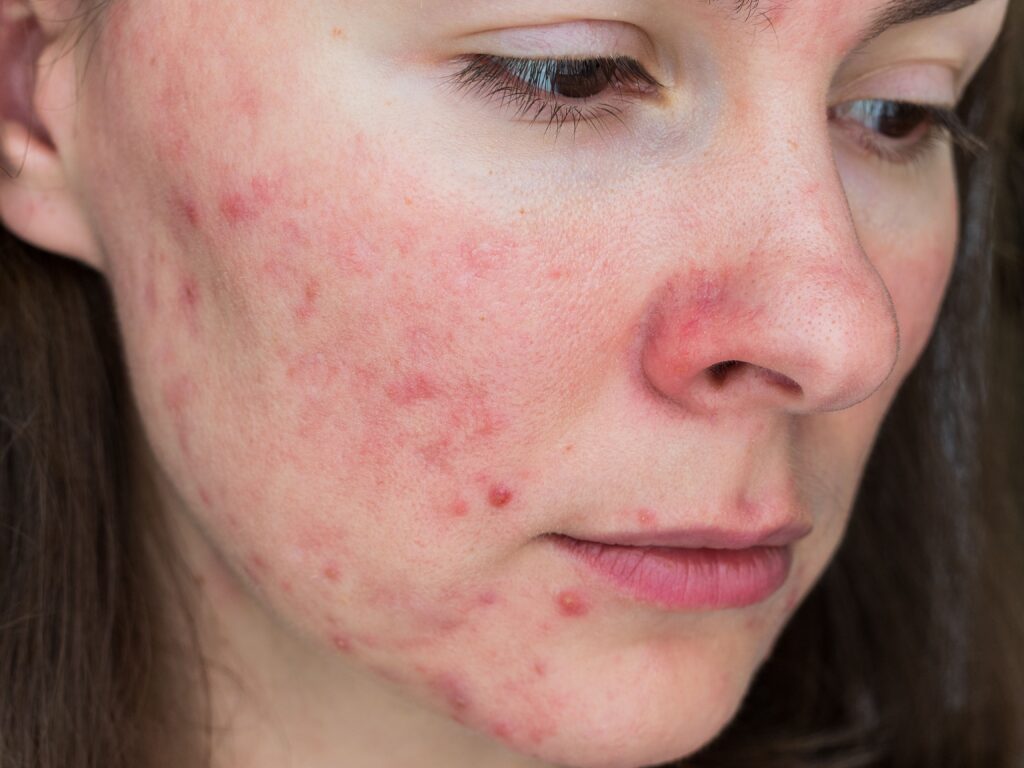Recent Chinese research has found new correlations between lifestyle factors, comorbidities, and rosacea, emphasizing the psychosocial impact on patients’ quality of life.1 The authors stress that this type of research is necessary in China, as the prevalence and effects of rosacea are not well-documented.
Methods & Materials
The single-center, observational case-control study took place at the dermatology outpatient department of the Second Affiliated Hospital of Harbin Medical University in China. Between May 2018 and May 2020, 200 patients with rosacea and 200 healthy participants were included in the trial. Over 70% of participants in each group were women.
Each patient completed a written questionnaire during an outpatient visit that assessed daily habits, environmental and dietary factors, comorbidities, levels of depression, and quality of life. The Dermatology Life Quality Index (DLQI) and the Patient Health Questionnaire-9 (PHQ-9) were used along with the chi-square to analyze correlations. A score of 21 to 30 on the DLQI indicated the condition has an extremely large impact on the patient’s life, while a score of 20 to 27 on the PHQ-9 indicated levels of severe depression.
“Despite these tools, the psychological effects of rosacea are often overlooked, particularly in Chinese populations where cultural views on skin health may increase distress,” the authors noted.
Correlations with Daily Lifestyle
Regarding lifestyle and daily habits, a higher number of smokers (20% vs. 7%, p < 0.001) and alcohol users (22% vs. 5.5%, p < 0.001) were found in the rosacea group. Those who more frequently used cosmetics and hair products had higher rates of rosacea as well (29.5% vs. 0.0%, p ≤ 0.001).
Patients who were frequently exposed to the sun and often had sunburns were significantly more likely to have the disease (47.5% vs. 0.0%, p ≤ 0.001). Similarly, it was found that rosacea is more prevalent in hotter weather (29.5% vs. 0.0%, p ≤ 0.001). Daily exercise (5.0% vs. 0.0%, p ≤ 0.001) and taking hot baths (12.6% vs. 0.0%, p ≤ 0.001) had similar significant links.
Correlations with Diet and Comorbidities
Dairy products, particularly milk and yogurt, had a higher association with rosacea prevalence (44.5% vs. 29%, p = 0.001). Along with this, those who drank hot coffee were more likely to have rosacea (14.5% vs. 8%, p = 0.040). No statistically significant differences were noted in other dietary factors, including fatty food, spicy food, hot tea, and sweet food.
Regarding comorbidities, the only significant association between the rosacea and control groups was diabetes mellitus. This study failed to show positive associations with rosacea and hypertension, high cholesterol, Helicobacter pylori, cancer, Crohn’s/ulcerative colitis, dry eye syndrome, chronic kidney disease, or migraines. However, previous studies have linked rosacea to cardiovascular diseases, gastrointestinal conditions, neurological disorders, and other metabolic disorders.2
Differences in Quality of Life
Those with rosacea had higher scores on the DLQI and PHQ-9, compared to the healthy controls. Rosacea had an extremely large effect on quality of life in 45.5% of patients, along with a large effect in 40.5% and a moderate effect in 9%. In the rosacea group, 46.5% had no depression, 26.5% had mild, 15.5% had moderate, 7.0% had moderately severe levels, and 4.5% had severe depression. To compare, 100% of participants in the control group reported no depressive symptoms. Further analysis confirmed that greater impairment to quality of life is linked to increased levels of depression (rho = 0.423, N = 400, p < 0.001).
Clinical Recommendations
When guiding patients with rosacea, the researchers recommend several additional treatment strategies for providers based on this data. Along with addressing physical symptoms, clinicians should focus on changing modifiable risk factors, including the avoidance of alcohol and smoking, the limiting of coffee and dairy intake, and the emphasis on sun protection and non-irritating cosmetics. Additionally, routine mental health screening and psychological support could enhance patient outcomes, especially in regions like China, where there is a cultural stigma regarding mental health.
“Further research with longitudinal, multicenter studies is necessary to clarify causal mechanisms and improve management strategies, which will aid in preventing and improving rosacea conditions and treatment approaches in the future,” the authors concluded.
References
1. Kunwar N, Jian D, Hui HY, Bai B. Exploring Factors, Comorbidities, Quality of Life (DLQI), and Depression (PHQ-9) in Rosacea Patients: A Comprehensive Analysis. J Cosmet Dermatol. 2025;24(8):e70337. doi:10.1111/jocd.70337
2. Haber R, El Gemayel M. Comorbidities in rosacea: A systematic review and update. J Am Acad Dermatol. 2018;78(4):786-792.e8. doi:10.1016/j.jaad.2017.09.016

